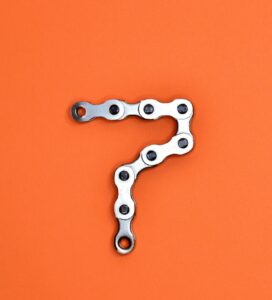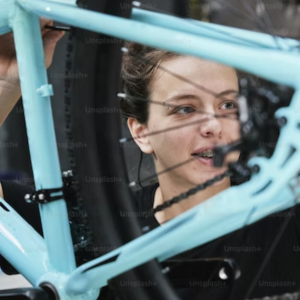A bicycle is a convenient and environmentally friendly method of transport. It is environmentally friendly because it has no emission of toxic gases. Most motor vehicles, especially the ones using petrol and diesel as fuel lead to the emission of toxic gases. Carbon dioxide, carbon monoxide, and sulfur dioxide are such gases. As a result of these emissions, the greenhouse effect dominates around the world. And it leads to global warming and many negative impacts on both mankind and the world.
Bicycles are a reliable solution to limit fuel combustion and hence the emission of greenhouse gases. Bicycles emit no gas and are therefore good for the atmosphere. Besides, riding a bicycle instead of traveling by car or a motorcycle is good for one’s health. It increases cardiovascular fitness, muscle strength and flexibility, and joint mobility. It strengthens your bones while reducing body fat. Cycling also helps with mental stress. You can go cycling in rural areas while enjoying the beauty of nature.
Precisely, a bicycle is a vehicle with two wheels attached to a frame, a handle, and pedals to steer. The two wheels are in line, one behind the other. The person who peddles the bicycle is commonly called the rider. The rider can sit on the saddle and ride the bicycle. Riding the bicycle is pedaling the pedals. The pedals are connected to a chain. And the chain rotates the rear wheel and subsequently the front wheel as well. Both wheels rotate and take you to wherever you want to go.
Uses of a bicycle
Bicycles are a mode of transportation. And it helps you to commute from one place to another. We know there are many modes of transportation such as motorcycles, cars, trains, buses, etc. Each mode has its advantages and disadvantages. Trains are faster than cars and buses. But since trains are public transportation modes, they have a schedule. Cars can provide a comfortable ride while motorcycles don’t. Motorcycle rides are bumpy and you may get all wet if it rains. Almost all these modes unless they are electric, use fuel.
Fuel consumption has many disadvantages for the environment. Partial combustion of fuel leads to the emission of toxic gases. Toxic gases such as carbon dioxide, carbon monoxide, and sulfur dioxide are greenhouse gases. Greenhouse gases lead to global warming.
For these doubts regarding negative environmental impacts, bicycles are the ultimate solution. Bicycles produce no toxic gases and are an efficient mode of transport. The basic uses of a bicycle are transportation, recreation, and sports. You can use a bicycle to go to school, buy groceries, and go anywhere you want. Bicycle rides to beautiful places of nature nourish the human mind. And hence it can be used for recreational purposes. Bicycle races are a common sport in the sports world. People go for bicycle races over months across many cities and villages.
Apart from the basic uses, riding bicycles is advantageous for human health. It gives you numerous advantages. Some of them are:
- Gives control over the weight
- Avoids cardiovascular diseases
- Reduces mental stress
- Strengthens bones
- Helps to maintain fitness
Different types of bicycles

Undoubtedly the bicycle market of every country has many types of bicycles. They may differ in appearance from one another. However, your personal preference and requirement are the crucial factors helping you to decide what you want. In addition to those, your budget also influences the decision. You got to buy what you can afford while it must fit the purpose. The bicycle market has many types of bicycles and here are some of them.
Road Bike
Road bikes are the best for fitness riding, commuting, event rides, touring, and racing. If you are purchasing a bicycle to go to school or go grocery shopping, this is good for you. Road bikes have a drop-bar handlebar. And it curls down toward the rear of the bike. Road bikes are not heavy and are easy to control. They have skinny tires. It fits right for most rides on road pavements.
Mountain Bike
Mountain bikes are loaded with features and details to make any ride better. The braking system of a mountain bike is naturally good. They can absorb all kinds of shocks to make the ride comfortable. As the name implies, mountain bikes are best for steep terrains. Unlike road bikes, they have lower gears allowing them to climb steep terrains.
Touring Bike
Touring bikes are much similar to road bikes but consist of some changes. Changes are to make the bicycle more suitable for long rides such as tours. For example, you are going on a road trip by bicycle. You need the bicycle to resist a heavy load (water, snacks, clothes, etc.). Touring bikes have the best features to make your ride comfortable.
Folding Bike
Folding bikes are super convenient for their users. As the name implies these bikes can fit right in a car trunk or a boat. You can fold your bike and carry it in a bag. This feature makes folding bikes more convenient for travelers. When your tour needs to travel across a river, you will get in a boat. You can’t leave your bike behind. Your folding bike will fit in a bag and you can carry it with you.
Track Bike
Track bikes are bikes used by racers and athletes. For bike races over the world, racers use track bikes. They are single and fixed gear. And might have more than one break. These bikes are not meant for road riding.
Recumbent Bike
Recumbent bikes are quite different from normal bikes. The rider’s position is a laid-back reclining one. This design depends on ergonomic reasons because it distributes body mass over a large area. Weight is supported by both the back and buttocks.
Hybrid Bike
Hybrid bikes contain mixed features of the road, mountain, and touring bikes. Hence it applies to many kinds of situations. Features inherent to hybrid bikes make them suitable over many surfaces.
Cyclocross Bike
Cyclocross bikes are for races on cyclocross courses such as mud, sand, rocks, and snow. They are not heavy but are tough and sturdy.
Electric Bike
While all other bikes require manpower to ride the bike, electric bikes are different. They have an electric motor installed. And you can charge it like a usual appliance. Mountain, road, and hybrid bikes have their electric versions to make rider’s life easier. Your body still gets the usual exercise as you need to peddle.
Parts of a bicycle
Bicycle parts might add up when it comes to different types of bicycles. But the basic parts are similar for all. The basic parts are:
- Frame
- Wheel
- Saddle area
- Front set
The frame consists of the top tube, down tube, seat tube, seat stay, and chain stay. The wheel is a combination of spokes, a hub, a rim, a tire, and a valve. The saddle and seat post comprises the saddle area. The front set is the handlebar grip, head tube, shock absorber, front brakes, and forks.
Apart from these parts, there are some others. There are pedals, crank arms, rear brakes, cogset, and rear derailleur. Then there is the chain, chainrings, and front derailleur. Each of these has its designated purpose while all are necessary for a comfortable ride.
Bicycle chain
The bicycle chain is simply a combination of interlinking pins, plates, and rollers transmitting power from the front sprocket to the rear sprocket. It is an essential component for a bicycle because you can’t ride it without a chain.
Bicycle chains are commonly made of steel while you may choose titanium bicycle chains if you prefer lightweight. Steel bicycle chains are susceptible to rusting in case of water contact. Rusting can be controlled using respective techniques.
Parts of a bicycle chain
A bicycle chain is a series of links combined. There are outer links, inner links, rollers, pins, and bushings in a bicycle chain. A single link has an outer link and an inner link along with two side plates. They are held together using pins.
How to replace a bicycle chain
Do we often have to replace the bicycle chain?
This is a good question because if it is necessary to replace bicycle chains all the time, we must know how to do that. However, replacing bicycle chains is not an everyday occurrence. If you are taking care of your bicycle chain on a daily basis, you are not in trouble. Chains wear as time passes and depend on how much you use the bicycle. Regular maintenance leads to controlled wear of the chain. You may also check the chain wear using the chain checker.
However, if the wear is significant, the chain needs immediate replacement. The cassette and chainrings will most need to be replaced most likely. Replacing the bicycle chain is tricky. And requires a bit of technical expertise. You need to know what you are doing.
Things you need
For the replacement of your bicycle chain, you need to have certain things with you. They are:
- Safety gloves
- Chain breaker tool
- Quick link pliers (in case chain using quick links)
- Piece of a broken spoke or zip tie (optional)
- A new chain
- Chain lubricant (not necessary)
The first thing to do
Bicycle chain replacement starts with checking the compatibility of the bicycle chain with the number of sprockets on your bike. These bicycle chains have their speed. There are single-speed chains while there are multi-speed chains too. For example, there are 6-7-8 speed chains, 9-speed, 10-speed, and 11-speed chains. It is mandatory to check the compatibility of the bicycle chain with the speed. However, both 9-speed and 10-speed chains are okay except for Campagnolo. You can check this by consulting an owner of a bike shop.
Steps to replace the bicycle chain

- Removing the existing chain – You need to first remove the existing chain so that the new one can be installed. If the existing chain has quick links, removing is easy. You may compress the link by hand and it’ll pop open. If it is stiff, you can use quick link pliers. Insert the quick link plier into the chain and press it together. Remove the pliers and the chain will separate.
- Cleaning the cassette – You need to check the condition of your bicycle’s chainrings and cassette. If they are worn out significantly, you need to replace them as well. Considering they are okay; you can clean the cassette and chainrings. A little bit of degreaser will do the job. Take a brush and apply some degreaser and scrub the cassette all the way through. Each clog needs cleaning. Try to clean the spaces between the gears too.
- Threading the new chain – Change to the chainring and smallest sprocket. Through the cage of the front derailleur, thread the new chain. Pull it over, through the upper jockey wheel of the derailleur, and around the rear cassette next. Then, wrap it around the lower wheel after carefully threading it through the cage while remaining inside the space between the plates.
- Finding the appropriate length – Your new chain needs some alteration of size. The largest length generating tension on the rear derailleur is what you need to find.
- Cutting to size – Take the chain tool and insert the tool into the link to need to be cut. Cut the link and be mindful to not harm the tool.
- Inserting the pin – After cutting the new chain into the desired size, you can insert the pin to hold the two ends of the chain.
- Pushing the pin in – The pin needs to be in place so that it is not troubling you.
Techniques to size the chain
There are three methods to size a bicycle chain. They are:
- Small-small method
- Big-big method
- Campagnolo chain sizing
Experts recommend considering the longest length from the results of the two upper methods.
Small-small method – In this method, the longest distance the chain can extend is measured. For that the gear of the smallest cog of the cassette and the smallest chainring matters. Fit the new chain on the smallest cog of the cassette and smallest chainring. You will find the longest length the chain can possibly be.
Big-big method – As the name implies, this is the opposite of the small-small method. You need to fit the new chain over the largest cassette and largest chainring. Ensure the chain bypasses the derailleurs. You may use a chain breaker to cut the new chain into the appropriate length as per the measurement.
Campagnolo chain sizing – Campagnolo recommends following this method for chain sizing. For 11-speed and under chains, the small-small method is applicable while the gap between the chain and pulley wheel has to be in the range of 8-15 mm.
Conclusion
We live in a forever-changing world experiencing wonderful technological advancements. In the long past, there were no vehicles for transport. But with the invention of the wheel, things changed over the years. In the beginning, it was just a wheel. Then it developed into carts and carriages. After all these years, here we are with numerous vehicles using different technologies. Some use fuel while some use electricity, and some are hybrid. Partial combustion of fuel leads to the emission of toxic gases. It is not environmentally friendly.
Bicycles are a solution for those negative impacts. They do not harm the environment and apart from that, good for your health. However, when using a bicycle to commute, you need to take care of it. If you are not maintaining it well, you won’t get the maximum benefits. You need to know how to replace a bicycle chain. The process is not that complicated. You can replace your bicycle chain if it is worn out at your home. There are some things you need. And you need to know how to size a bicycle chain.
